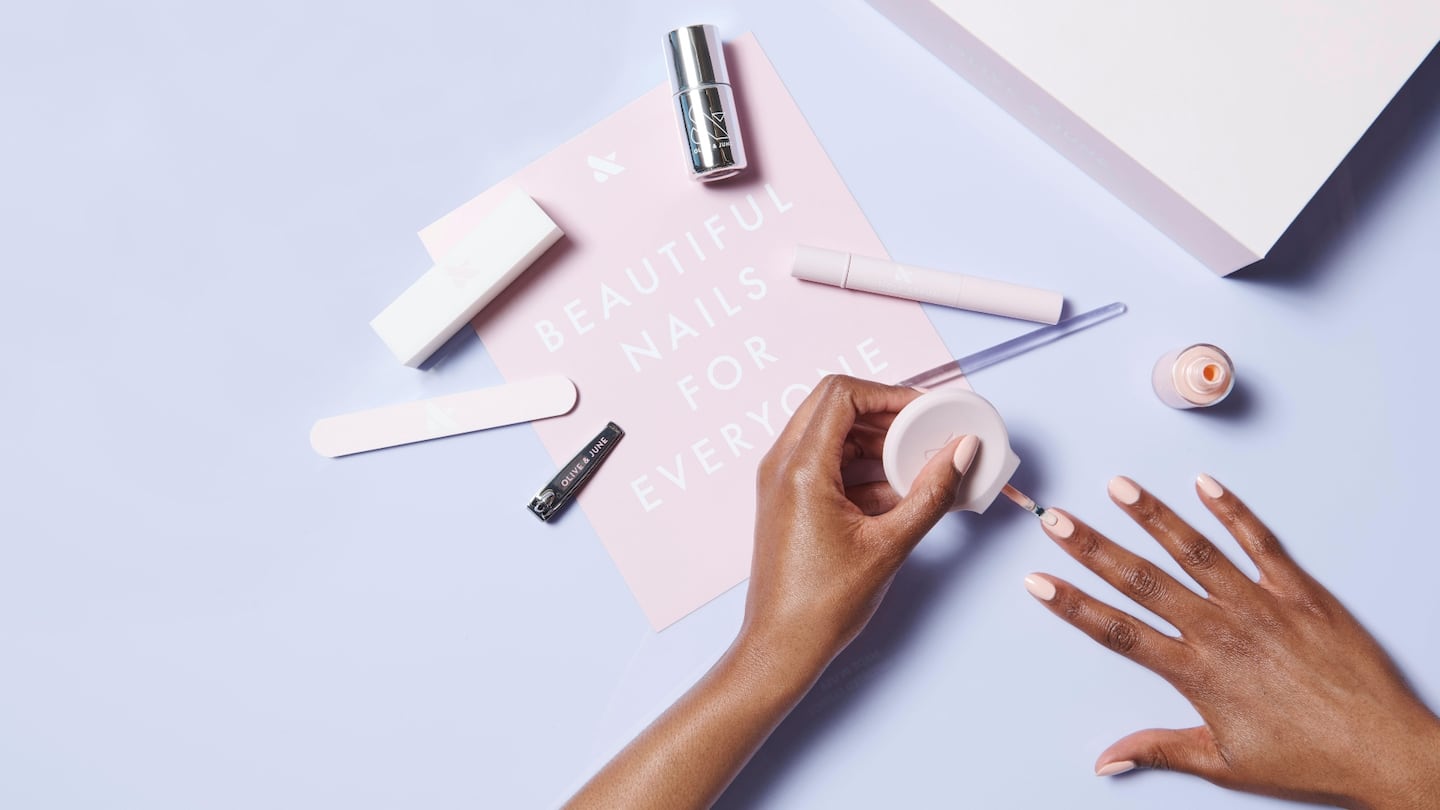
The Business of Fashion
Agenda-setting intelligence, analysis and advice for the global fashion community.

Agenda-setting intelligence, analysis and advice for the global fashion community.

In 2019, six years after opening the first Olive & June nail salon in Beverly Hills, the brand’s founder Sarah Gibson Tuttle made something of a risky bet: She started selling products online that would allow clients to buy and do their own nails at home.
But while observers may have seen the $50 manicure kits — replete with nail files, clippers and a cuticle serum — as a counterintuitive play that could cannibalise the core Olive & June business, Tuttle saw an emerging market.
“We knew that we were at the precipice of a DIY [do-it-yourself] nail evolution,” she said. “We have always had the mission of making it possible for everyone everywhere to have salon-perfect nails at an affordable price.”
What Tuttle couldn’t have predicted, however, was how prescient the move was. Months later, the pandemic would close salon doors and make DIY nails a necessity. Over the next year, Olive & June created more at-home nail products and ramped up its e-commerce. It even patented its “Poppy,” a nail polish bottle handle that improves people’s grip when they paint their nails with their non-dominant hand.
ADVERTISEMENT
Three years after the pandemic, Olive & June has closed its salons permanently and is solely focussed on its product business. It’s paid off: The company is expected to cross the $100 million threshold this year, according to a person with knowledge of its finances.
For years, nail salons and spas have developed their own products, mostly nail polishes, to pad revenue and support the services they offer. But like Olive & June, a host of other salons and spas, including Tenoverten, Chillhouse and Manucurist, have seen these products become a larger part of their businesses, scaling back their brick-and-mortar locations or closing them altogether.
The at-home nail care sector is niche and its current size is hard to determine, but it sits within a $2 billion market for general nail products in the US alone, according to estimates from market research firm Circana. The brands in this burgeoning sector are seeing healthy growth, as post-pandemic consumers are more accustomed to doing their own nails at home, experts say. Chillhouse and Manucurist are on pace to double their sales this year, for example.
Ongoing inflation and the resumption of student debt repayments in the US could push more consumers to buy at-home nail products in the next year. With that in mind, at-home nail brands are widening distribution through partnerships with retail giants like Target and expanding their line of nail treatments, where they have the most room to innovate.
“What’s happening here is a permanent shift into DIY,” Tuttle said. “When consumers unlock the power of doing it themselves, via press-on or polish, it unlocks behavioural shift.”
Though they all sell via their own channels, nail brands that transitioned their business’ focus from operating salons to selling products understand that multi-brand retail is the primary way to reach beauty consumers. Many of these brands are getting their biggest sales bumps in big-box retailers where they can reach a wider audience and position themselves as a leader in a growing category.
Olive & June, for example, launched its goods on its own e-commerce site in 2019 and entered all Target stores later that year. Before inking a partnership, the brand conducted surveys with its consumers about where they shop for beauty, along with consulting sales data for nail products across different retailers. Olive & June landed on Target because the retailer had a significant share of mass market consumption of nail products, Tuttle said.
The retail giant was Olive & June’s exclusive wholesale partner from 2019 to 2022; this year it entered Walmart and Walgreens. By the end of the year, the company will be in more than 7,000 retail locations.
ADVERTISEMENT
For Chillhouse, which sells press-on acrylic nails, wholesale has been a salve as the company sees a dip in sales on its online storefront as digital ads on social media and search remain expensive. It’s also experienced a foot traffic slowdown at its salon in New York’s Soho neighbourhood.
Stores like Target have been an inexpensive brand awareness channel that also accounts for much of Chillhouse’s sales growth. Those partners have begun increasing their assortment of Chillhouse products. This year, Chillhouse expects to double sales, with nearly 50 percent of its revenue coming from wholesale partnerships.
Even as they expand their retail presence, some companies are also working to preserve growth in their DTC channels.
Nail care brand Tenoverten, which sells its wares online and operates a salon in Manhattan, also counts Target as a partner and has recently moved into Urban Outfitters, Free People and specialty beauty retailer Violet Grey. But the brand offers exclusive items on its site, such as the ability for customers to customise a box of three nail colours. These boxes are usually curated with pre-selected nail colours when they are sold in multi-brand retailers. That tactic has aided the company’s 70 percent growth in its DTC business since it relaunched its site in 2021, and that channel generates double digit growth year over year, said Adair Ilyinsky, co-founder of Tenoverten.
As at-home manicure kits become more prevalent in beauty aisles, emerging brands in this sector are developing more nail care treatments to add newness to an established category.
When Tenoverten relaunched its e-commerce site in 2021 (it began selling its Tenoverten brand non-toxic nail polish in its salons in 2012) it introduced products like hand masks and cuticle-restoring rose oil. The plan was to get consumers to think of nail care as skin care, including the skin on one’s hands and feet.
Most of the 25 new products the brand has released quarterly since its relaunch have been such treatments, including a moisture-locking balm for soles and a liquid-based cuticle remover.
“We don’t like to produce things just to produce them. We like to make sure that we’re really filling a hole in the market,” Ilyinksy said. “We’re always focused on innovating and offering new products, while recognising the world doesn’t need more products that are redundant.”
ADVERTISEMENT
Other brands have imbued science and technology into their products to modernise the manicure with tools that protect the health of customers’ nails.
In 2019, Paris-based brand Manucurist introduced its $125 “Green Flash LED” gel polish manicure kit, replete with polish, an LED machine that promises to dry nails instantly and an acetone-free remover that enables users to neatly peel off their polish like a sticker. Today, the brand’s attempt to innovate a popular manicure style is resonating in several markets, such as France, the UK and the US. The Green Flash kit accounts for 70 percent of Manucurist’s annual sales. The company is on pace to double its revenue to €40 million ($42.2 million) in 2023, founder and chief executive Gaëlle Lebrat Personnaz said.
“This boils down to the advances in manicures,” said Larissa Jensen, senior vice president and global beauty industry advisor at Circana. “The technology and the changes in the nail industry are really what birthed these different types of products.”
Editor's Note: This article was revised on 7 November. A previous version misstated the price of Manucurist's “Green Flash LED” gel polish manicure kit and Gaëlle Lebrat Personnaz's job title.
As demand for nail products and services still lags behind 2019 levels, nail art and has proven to be a bright spot in the category.
Kits for do-it-yourself manicures, keratin treatments, hair dye and more saw success in a world where salon doors were closed. Can they keep the buzz going?
In an industry once ruled by polar opposites — the cheap and the extravagant — a growing number of entrepreneurs are making upscale manicures more accessible.

Malique Morris is Direct-to-Consumer Correspondent at The Business of Fashion. He is based in New York and covers digital-native brands and shifts in the online shopping industry.
The Spanish beauty and fashion conglomerate’s smart acquisitions and diverse portfolio could be a big draw for investors. Plus, Adidas is set to confirm its stellar first quarter.
How not to look tired? Make money.
In a rare video this week, the mega-singer responded to sceptics and gave the public a look at what her beauty founder personality might be.
Request your invitation to attend our annual gathering for leaders shaping the global beauty and wellness industry.